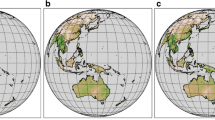Abstract
This paper reports the results of a modeling study carried out with two objectives, (1) to estimate and compare effective spectral characteristics (central wavelength, bandwidth and bandpass exo-atmospheric solar irradiance Eo) of various spectral channels of LISS-III, WiFS, LISS-III*, LISS-IV and AWiFS onboard Indian Remote Sensing Satellites IRS-ID and P6 using moment method based on the laboratory measurements of sensor spectral response, and (2) to quantify the influence of varying sensor spectral response on reflectance and Normalized Difference Vegetation Index (NDVI) measurements using surface reflectance spectra corresponding to different leaf area index conditions of crop target obtained through field experiment. Significant deviation of 4 to 14 nm in central wavelength and 1.6 to 14.07 nm in spectral width was observed for the corresponding channel of IRS sensors. Coefficient of variation of the order of 0.1 to 1.11% was noticed in Eo among various IRS sensors, which could induce a difference of 0.72 to 3.35% in the estimation of top of atmosphere reflectance for crop target. The variation in spectral response of IRS sensors implied a relative difference of the order of 0.91 to 3.38% in surface reflectance and NDVI measurements. Polynomial approximations are also provided for spectral correction that can be utilized for normalizing the artifacts introduced due to differences in spectral characteristics among IRS sensors.
Similar content being viewed by others
References
Burgess, D.W. and Pairman, D. (1997). Bidirectional reflectance effects in NOAA-AVHRR data.International Journal of Remote Sensing,18: 2815–2825.
Dadhwal, V.K., Singh, R.P., Dutta. S. and Parihar. J.S. (2002). Remote sensing based crop inventory: a review of Indian experience.Tropical Ecology,43: 107–122.
Duggin, M.J. (1980). Effect of instrument spectral response on use of the Landsat MSS for vegetative disease assessment.Applied optics,19: 2081–2083.
Epiphanio, J.C.N. and Huete, A.R. (1995). Dependence of NDVI and SAVI on sun sensor geometry and its effect on fAPAR relationships in alfalfa.Remote Sensing of Environment,51: 351–360.
Galvào, L.S., Vitorello, I. and Pizarro, M.A. (2000). An adequate band positioning to enhance NDVI contrasts among green vegetation, senescent biomass and tropical soils.International Journal of Remote Sensing,21: 1953–1960.
Galvão, LS., Vitorello, I. and Filho R.A. (1999). Effects of band positioning and bandwidth on NDVI measurements of tropical savannas.Remote Sensing of Environment 67: 181–193.
Gao, X., Huete, A.R., Ni, W. and Miura, T. (2000). Optical- biophysical relationships of vegetation spectra without background contamination.Remote Sensing of Environment,74: 609–620.
Hansen, S., Peterson, J., Esplin, R. and Tansock, J. (2003). Component level prediction versus system level measurement of SABER relative spectral response.International Journal of Remote Sensing,24: 389–402.
Hudson, R.D. and Hudson, J.W. (1975). Infrared detectors. Halsted Press. pp. 392.
Huete, A., Justice, C. and Liu, H. (1994). Development of vegetation and soil indices for MODIS-EOS.Remote Sensing of Environment,49: 224–234.
Huete, A.R. (1988). A soil-adjusted vegetation index (SAVI).Remote Sensing of Environment,25: 295–309.
Huete, A.R. and Liu, H. (1994). An error and sensitivity analysis of the atmospheric- and soil-correcting variants of the NDVI for MODIS-EOS.IEEE Trans. Geoscience & Remote Sensing,32: 897–905.
Kaufman, Y. J. (1989). The atmospheric effect on remote sensing and its correction. Theory and Applications of Optical Remote Sensing, G. Asrar Ed. New York: Wiley.
Liang, S. (2004).Quantitative remote sensing of land surface, Wiley Interscience, pp. 14–18.
Navalgund R.R. (2006). Indian Earth observation systems: An overview.Asian Jl. Geoinformatics,6: 17–25.
Neckel, H. and Labs, D. (1984). The solar radiation between 3300 and 12500 A, °,Solar Physics,90:205–210.
Palmer, J.M. (1984). Effective bandwidths for Landsat- 4 and Landsat-d’ multispectral scanner and thematic mapper subsystems.IEEE Transactions on Geoscience and Remote Sensing,22: 336–338.
Pandya, M.R., Singh, R.P., Chaudhari, K.N., Oza, SR., Bairagi G.D., Dadhwal, V.K. and Parihar J.S. (2004). Spectral and radiometric evaluation of sensors onboard IRS-P6. Scientific Report: SAC/RESIPA/ SR-02/Oct 2004. page: 3–12.
Pandya, M.R., Singh, R.P., Murali, K.R., Babu, P.N., Kirankumar, A.S. and Dadhwal, V.K. (2002). Band pass solar exoatmospheric irradiance and Rayleigh optical thickness of sensor onboard IRS-1B, 1C, 1D and P4.IEEE Transactions on Geoscience and Remote Sensing,40: 714–718.
Pandya, MR., Dadhwal, V.K. and Navalgund, R.R. (2000). Effect of WiFS viewing geometry on crop reflectance: a simulation study using SAIL model.International Journal of Remote Sensing,21: 1931–938.
Price, J.C. (1987). Calibration of satellite radiometers and the comparison of vegetation indices.Remote Sensing of Environment,21: 15–27.
Richter, R. (2000). Bandpass-resampling effects on the retrieval of radiance and surface reflectance.Applied Optics. 39:5001–5005.
Shine, K.P. and A. Henderson-Sellers (1985) The influence of satellite spectral response on the analysis of satellite imagery at high latitudes.International Journal of Remote Sensing,6: 29–34.
Slater, P.N. (1979). A re-examination of the Landsat MSS.Photogram. Eng. & Remote Sensing,45: 1479–1485.
Teillet, P.M., Barker, J.L., Markham, B.L., Irish, R.R., Fedosejevs, G. and Storey, J.C. (2001). Radiometric cross-calibration of the Landsat-7 ETM+ and Landsat-5 TM sensors based on tandem data sets.Remote Sensing of Environment,78: 39–54.
Teillet, P.M., Staenz K. and Williams, D.J. (1997). Effects of spectral, spatial and radiometric characteristics on remote sensing vegetation indices of forested regions.Remote Sensing of Environment.61: 139–149.
Trishchenko, A.P., Cihlar, J. and Li, Z. (2002). Effects of spectral response function on surface reflectance and NDVI measured with moderate resolution satellite sensors.Remote Sensing of Environment,81:1–18.
Wang, M., Franz, B.A., Barnes, R.A. and McClain, C.R. (2001). Effects of spectral bandpass on SeaWiFS- retrieved near-surface optical properties of the ocean.Applied Optics,40: 343–348.
Author information
Authors and Affiliations
Corresponding author
About this article
Cite this article
Pandya, M.R., Singh, R.P., Chaudhari, K.N. et al. Spectral characteristics of sensors onboard IRS-1D and P6 satellites: Estimation and their influence on surface reflectance and NDVI. J Indian Soc Remote Sens 35, 333–350 (2007). https://doi.org/10.1007/BF02990789
Received:
Revised:
Issue Date:
DOI: https://doi.org/10.1007/BF02990789



